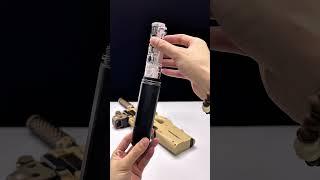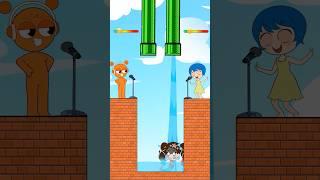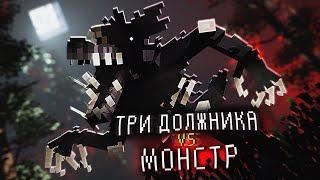
Solving A Classic Interview Puzzle - Google Puzzle for Software Engineers
Комментарии:

I actually solved all of them. C was a bit tricky but I figured it out. I appreciate the efforts that you put into making and animating these puzzles. Waiting for more new logic every week.👍👍👍❤❤❤
Ответить
Another solution to C could be similar to B.
As we divided B into 3 squares, further divide these 3 squares into 4 triangles(or squares).
Then you have 12 identical triangles(or squares)
Now, just group them into groups of 3 to get 4 groups.
This can form your solution also, or something different.

It's well-known (been known and researched for about 20 years now) that ability to solve puzzles at interviews does not correlate with job performance. That's why they were largely abandoned as an interviewing tool. I'm surprised to see the idiocy coming back. BTW, research into work performance has more interesting findings up its sleeve. For example: (1) open-seating office layout decreases job performance, and (2) so does the short American PTO (it was found, for example, that the average German employee brings more revenue to his employer with his 6-week PTO than the average American one with his 2-week PTO. Of course, nobody listens. It's like covid and science, I guess 🙂
Ответить
Solved for all four. My solution for C is different (as I understood equal as meaning equal area pieces, otherwise should have mentioned identical pieces instead of equal pieces):
1) divide C into 2 identical trapeziums in the middle.
2) for each trapezium, divide using line passing through middle point of the two parallel lines.

The answer to A is incorrect because the pieces are not "equal": they are mirror images of each other.
Ответить
This was confusing. The length of the smaller square and the length of the larger square are given. So, I thought the primary exercise was to find the area of each, subtract and then divide. It would have been clearer if the lengths wasn’t presented.
Ответить
Yeah, I could see how do that 52 seconds in.
Ответить
I'm a subscriber of some channels uploading critical thinking puzzles. Your channel is the best 🥰
Ответить
Very interesting puzzle
Your explanation is crystal clear, I enjoyed it
Please upload next puzzle soon

Hey ammar just came to know about your channel.. I am really happy to see that your channel has grown with soo many subscribers and views.... And content is just superb.... it reflects your hard work.. And no doubt the accent oration and confidence is showing reflection of your father and wisdom from your mom.... Subscribing now... ... Stay blessed.. All the best 🎉
Ответить
Very nice. And quite important. Cheers.
Ответить
OMG: I solved all of them in my head in 35 seconds just by looking on the thumbnail. Watching the video was fun as a bonus. The only difference was that I made the lines vertical in the D square. Too easy. If this is indicative of the level at Google then don't bother to offer me a job there. BTW: My IQ is 157.
Ответить
I knew for part D I could just draw 4 lines, but for C I thought of cutting it diagonally like A, then dividing those two parts in half again
Ответить
It's really a good excercise for me. Solved in one go.
Thank you

I couldn't get D, and somehow as soon as you started talking about conditioned thinking, I looked back at D and realized the solution before you showed the lines. Interesting video!
Ответить
Assalamualaikum ammar bhai i sent you request on LinkedIn I am also power apps developer i need some suggestions from you kindly accept
Ответить
For C you have also the option of drawing the diagonals of the 3 smaller whites squares-> 12 identical triangles and then easy to split into 4 🙂 you don't even need to think about the pattern of the others !!
Ответить
I don't understand how D is a proper solution if you can't use tools/rulers. How can you know the lines are equadistant? Same with C, honestly. A and B both involve drawing lines from point to point, or i guess for B from point to line parallel with another line. For C I came up with 4 triangles, drawing from corner to corner. I feel like D is not possible without tools, at least for more than a rough estimation.
Ответить
As a SW Engineer, I admit I totally misinterpreted the problem. I thought you had to actually use techniques that could get you exact positions of your dividing lines (e.g. bisection). In the block D example, they divide it visually - with no demonstrated way of knowing exactly where to place the lines, other than to hand-wave and basically say "well, I would use a calculator to get the correct answer".
I bet these days people "pass" by explaining they would just ask ChatGPT to do their work for them...

Am I the only one to think that your solution for A doesn't give two "identical" pièces, as requested, but two symmetrical pieces instead? B, C and D solutions are identical.
Ответить
Great one. So happy that I almost solved the puzzle the same way. I guess, the conditioned mindset didn't affect me. I just went for the easiest solution. 😅
For the area C, there are 3 squares considering each square is of 1 cm² area. The total is 3 cm². Dividing by 4, it will be 0.75 cm² each. It's easy to divide outside squares by cutting the length of 0.75 cm . Now the remaining part, just draw the diagonal line, and it is divided into 2 identical areas of 0.75 cm² each.
But, your solution was amazing. It was all in front of our eyes, and we never observed. 😮
P.S.: Oh, it's so hard to explain the solution just by typing down here for me. 😅

I really admire your videos from you like heart❤
Ответить
i already did ut...hahaah.. then i thought naaa...but i thought why not ...actually with the same logic it can be done in plenty of ways..i do have more than one solution
Ответить
All answered correct!
Ответить
Hey amar, i am a student and genuinely interested in such riddles. Could you recommend me some online sources from which you gain such fascinating Puzzles and their answers
Ответить
went through all the 51 video. thanks for the playlist. I have a interview on tuesday will update how it went.
Ответить
This question tricked me😂
Ответить
Awesome man
Ответить
Amar Sir Post More Amazing puzzle
Ответить
In c block we can create triangle also
Ответить
LESSON 2 IS VERY USEFUL. It happens to me most of the times in coding quesitons
Ответить
I solved C by imagining a diagonal cut similar to A, as well as a perpendicular cut strategically placed such that it divides each half into two equal pieces
Ответить
I did exaxtly like this
Ответить
Your channel's dying
Ответить
No no.. not possible the question does not have anything to divide with and what is the material of these squares ?
Can we fold it ? Is it brittle ? Do I need scissors or precision cutting device ?
It's not tricky just absurd and illogical question.

Block C explanation of the thinking process strikes me as "pray for the solution to hit you in the face"
May I sugguest how I found it myself, using rather rational thoughts
1. Analysing lessons learned (pattern recognition)
When I saw the challenge of it, I tried to find some simpler problem which looked analogical. Block A had also a strange looking solution and I wondered what lesson learned I could get from that one on figuring out a procedure to methodically finding that strange morphologies.
I figured that if I considered the partition of the white region into the simplest equal parts, three squares, then any partition of them parts into equal subparts will give equal parts throuthoughy the whole zone too, as well potential to rearranging them into new assemblies if the same number of subparts.
In Block A, since I needed to divide by two, while I had three, I needed to divide the area into a common multiple of equal parts, six, then arranging the smaller partitions into assemblies of three, ie, two blocks of three equal parts.
The partition of the three equal squares into two pieces each turned to work out as 45º rectangles, which then arrenged into blocks of three would give the shape we sorted out intuitively.
2. Applying lesson learned
Applying this strategy, now we had the white zone of Block C separated into the three simplest equal partitions. Now, since we needed four and not three equal partitions, we need to find a common multiple, twelve. So each square must be fractioned into four equal elements.
I first tried breaking it into triangles again, but assemblies of three triangles don't really make for building elements. Then I tried a four square partition. Assemblying three squares into that L shape did allow to fill the white zone, and therefore the solution was found.
3. Comments
Mind I said "a common multiple", not the smallest one. If the shapes I found dividing the squares into the first order of partitions didn't give me any results, breaking down further into smaller sub-pieces with a factor of 2, 3, 4, etc, may have eventually solved the problem.
Thanks for reading!

Mr ammar , please continue the series
Ответить
Awesome
Ответить
Why on a hiatus bro?
Ответить
'D' got me.
Ответить
Can't we divide the white part of C into 4 identical triangles ??
It's one of the options.

Really got stucked in D coz of the conditional mindset😅
Ответить
the C part can be divided in another shape like the A but put a straight line in the middle of C diagnolly
Ответить
There is an error in A the 2 parts are not the same one is the mirror image of the other. Not unless you flip one upsidedown if it was like a piece of paper
Ответить
the D part is the evidence i am mentally damaged by difficult puzzles
Ответить
Soo are we to assume we can just meassure the sides, because i at least cant draw 4 perfectly spaced parallels by hand
Ответить
The problem is ill-specified.
(1) What do you mean by “divide”: by Euclidean construction or some other way?
(2) What do you mean by “equal”: geometrically congruent (allowing reflection?) or just equal in area?
(3) What do you mean by “pieces”: can the pieces be formed by assembling smaller pieces?

For Solving C i tore the White region like A and flipped one piece to form a rectangle and then its easy to divide by 4
Ответить
![[SFM FNaF] FULL asdfMovie WITH DELETED SCENES [SFM FNaF] FULL asdfMovie WITH DELETED SCENES](https://invideo.cc/img/upload/VUFUOUVuLVQxUko.jpg)
























